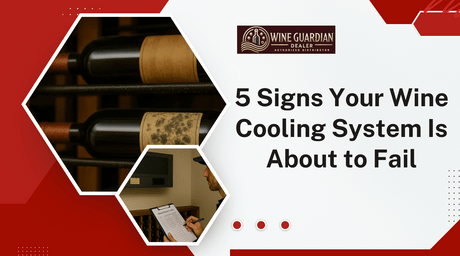
5 Signs Your Wine Cooling System Is About to Fail
Don’t wait for a costly surprise. Wine Guardian Dealer breaks down the top 5 signs your wine cooling system may be failing — and how to fix it before damage...
Jim Hopper
In Stock & Ready to Ship – Order Your Wine Cooling System Today!
Free Wine Cellar Expert Consultation | 📞 Call 1-800-260-1712
Start with a free expert consult—cooling system sizing, racking options, and no upsells.

Build your dream wine cellar—without costly mistakes or guesswork.
By Jim Hopper, Wine Cooling Expert
Maintaining the right environment in your wine cellar is crucial for preserving the quality of your wine collection. One of the key factors is to control humidity, ensuring it stays within the optimal range to prevent wine spoilage. This involves techniques for humidity management, including both active and passive methods depending on the climate.

Wine cellar humidifiers are essential devices for maintaining these optimal humidity levels. They help prevent cork drying and oxidation, ensuring your wine remains in perfect condition.
Most people understand that wine needs to be kept cool—but what about humidity?
Wine cellar humidification is just as critical as temperature when it comes to proper wine storage. Without enough humidity, corks can dry out and shrink. If that happens, oxygen sneaks in, and your wine oxidizes—spoiling the flavor and ruining the bottle. A wine cellar must be 100% sealed to prevent humidity and temperature fluctuations that can affect wine quality.
Whether you’re designing a custom cellar or managing an existing one, keeping the right wine storage humidity is essential to protect your investment.
In this guide, you’ll learn:
Let’s keep your wine aging beautifully. 🍷 For complete preservation strategies and equipment recommendations, explore our full Wine Aging and Preservation: Protecting Your Collection for the Next 30 Years.
Wine is sealed with cork for a reason—it allows micro-oxygenation, a key part of aging. But cork is organic and vulnerable to its environment. If your cellar is too dry or too damp, problems start quickly.
Here’s how wine reacts to poor humidity:
|
Humidity Level |
What Happens |
|---|---|
|
Too Low (< 50%) |
Corks dry, wine evaporates or oxidizes |
|
Too High (>75%) |
Mold growth, peeling labels, mildew on racks |
|
Just Right (60–70%) |
Corks stay moist, labels preserved, wine ages perfectly |
Proper wine cellar humidity control helps ensure that your wines stay sealed, safe, and stable.
The recommended humidity level for wine storage is:
This range is ideal to:

High humidity levels can promote mold growth on wine bottles and labels. It is crucial to maintain this humidity range in wine rooms to prevent issues like condensation and mold growth.
📘 Related: Wine Cellar Temperature: 7 Signs It’s Off
Even if your temperature is perfect, these red flags suggest your wine storage humidity needs attention:
If any of these sound familiar, it’s time to consider better humidity control for your wine cellar.
Before adding any humidifier, make sure your cellar has:
Wine cellars need to be designed with appropriate insulation and vapor barriers to effectively manage humidity.
📘 Learn more: Wine Cellar Insulation Guide
Not all wine cooling systems manage humidity. Many just remove moisture. Closed-cell foam is recommended for vapor barriers in wine cellars because it prevents oxygen from penetrating the space.
That’s why it’s important to install a system designed specifically for wine cellar climate control—like Wine Guardian.

A wine cellar humidification system is the best way to stabilize moisture levels.
Whether your cellar is in the basement, attic, or closet, this is the best humidifier for a wine cellar hands down. The Wine Guardian Freestanding Humidifier is designed to complement the beauty of stored wine bottles.
High-quality humidifiers require regular maintenance for optimum function, including cleaning and replacing water panels or pads.
Selecting the right wine cellar humidifier is crucial for maintaining the perfect environment for your wine collection. Here are some key factors to consider:
By considering these factors, you can choose a wine cellar humidifier that meets your needs and helps protect your valuable wine collection.
There are various types of humidifiers available for wine cellars, each with its own advantages. Here’s a breakdown of the most common types:
By understanding the different types of humidifiers available, you can choose the one that best suits your wine cellar’s needs and ensures your wine collection is stored in optimal conditions.
“Our corks were drying out in winter—even with a cooling system. Adding a Wine Guardian humidifier made all the difference. Now we’re holding 65% humidity consistently.”
— Rachel F., Boulder, CO
“Humidity used to spike every summer. Since adding the Wine Guardian system, it’s been a perfect 60–65% year-round. Worth every penny.”
— Mike T., San Diego, CA
Don’t leave your wine at risk. A small investment in humidity control can protect thousands of dollars in bottles—not to mention your peace of mind.
👉 Shop Wine Guardian Humidification Systems
Compatible with all Wine Guardian cooling systems.
📞 Call 1 (800) 260-1712 for a FREE climate control consultation
We’ll help you choose the right humidification system for your cellar, based on your location, room size, and environment.
60–70% RH is ideal for proper wine storage. It keeps corks sealed without promoting mold.
Often yes—especially in dry climates or newly constructed homes. Basements can vary more than expected. Wine cellars in arid climates require humidifiers to maintain consistent humidity levels.
No. Regular units aren’t built for sealed or climate-controlled spaces and can over-humidify quickly.
Some models help maintain it, but adding a dedicated Wine Guardian humidifier offers better precision and control.
Corks shrink, letting in air. That causes oxidation, spoilage, and changes the wine’s flavor and aroma.
🛒Shop our most-loved Wine Guardian cooling systems today.
🛠️Protect your wine with the most trusted systems on the market.
❤️Tested, reviewed, and loved by serious collectors like you.